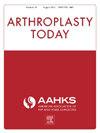膝关节置换术后1年膝关节损伤和骨关节炎预后评分的最小临床重要差异能否预测全膝关节置换术后的满意度?
IF 2.1
Q3 ORTHOPEDICS
引用次数: 0
摘要
管理医疗系统已经表达了对使用患者报告的结果测量(PROMs)来确定全膝关节置换术(TKA)手术资格的兴趣。TKA后PROMs与患者满意度之间的关系是一个活跃的研究领域。我们询问(1)TKA后1年膝关节损伤骨关节炎结局调查(kos, JR)中患者满意度与实现最小临床重要差异(MCID)之间的关系是什么;(2)KOOS, JR从术前到TKA后1年预测患者满意度的最佳变化是什么;(3)是否有其他术前因素影响TKA后患者满意度。方法回顾性队列研究分析了在单一门诊手术中心接受原发性全髋关节置换术的患者。患者分别在术后基线、12周、6个月和1年完成kos、JR和Veterans Rand 12项健康调查(VR-12)。满意度采用李克特量表进行评估。采用Logistic回归、最佳拟合模型、分类和回归树分析来确定满意度的预测因子。结果600例患者中,满意率为93.7%。71.8%的满意患者达到MCID, 44.7%的不满意患者达到MCID (P <;措施)。KOOS, JR术前至1年的变化(优势比1.09,P <;.001)和术前VR-12心理成分评分(优势比1.05,P = .007)预测满意度。oos无变化阈值,JR预测满意度。结论虽然kos、JR改善与满意度相关,但实现MCID并不是可靠的预测因子。术前因素,包括VR-12心理成分评分,可以更好地识别tka后可能满意的患者。需要对更大的队列进行进一步研究,以完善基于prom的资格标准。本文章由计算机程序翻译,如有差异,请以英文原文为准。
Does Achieving the Minimal Clinically Important Difference in the Knee Injury and Osteoarthritis Outcome Score for Joint Replacement at 1 Year Postoperative Predict Satisfaction Following Total Knee Arthroplasty?
Background
Managed care systems have expressed interest in using patient-reported outcome measures (PROMs) to determine surgical eligibility for total knee arthroplasty (TKA). The relationship between PROMs and patient satisfaction following TKA is an area of active research. We asked (1) what is the relationship between patient satisfaction and achieving minimal clinically important difference (MCID) in Knee Injury Osteoarthritis Outcomes Survey for Joint Replacement (KOOS, JR) at 1 year post-TKA, (2) what is the optimal change in KOOS, JR from preoperative to 1-year post-TKA that predicts patient satisfaction, and (3) are there additional preoperative factors that influence patient satisfaction following TKA.
Methods
A retrospective cohort study analyzed patients who underwent primary TKA at a single ambulatory surgery center. Patients completed KOOS, JR and Veterans Rand 12-Item Health Survey (VR-12) at baseline, 12 weeks, 6 months, and 1 year postoperatively. Satisfaction was assessed using a Likert scale. Logistic regression, best-fit modeling, and classification and regression tree analyses were performed to determine predictors of satisfaction.
Results
Among 600 patients, 93.7% were satisfied. MCID was met in 71.8% of satisfied patients vs 44.7% of unsatisfied patients (P < .001). Preoperative to 1-year change in KOOS, JR (odds ratio 1.09, P < .001) and preoperative VR-12 mental component scores (odds ratio 1.05, P = .007) predicted satisfaction. No change threshold for KOOS, JR predicted satisfaction.
Conclusions
While KOOS, JR improvement correlated with satisfaction, achieving MCID was not a reliable predictor. Preoperative factors, including VR-12 mental component scores, may better identify patients likely to be satisfied post-TKA. Further research on larger cohorts is needed to refine PROM-based eligibility criteria.
求助全文
通过发布文献求助,成功后即可免费获取论文全文。
去求助
来源期刊

Arthroplasty Today
Medicine-Surgery
CiteScore
2.90
自引率
0.00%
发文量
258
审稿时长
40 weeks
期刊介绍:
Arthroplasty Today is a companion journal to the Journal of Arthroplasty. The journal Arthroplasty Today brings together the clinical and scientific foundations for joint replacement of the hip and knee in an open-access, online format. Arthroplasty Today solicits manuscripts of the highest quality from all areas of scientific endeavor that relate to joint replacement or the treatment of its complications, including those dealing with patient outcomes, economic and policy issues, prosthetic design, biomechanics, biomaterials, and biologic response to arthroplasty. The journal focuses on case reports. It is the purpose of Arthroplasty Today to present material to practicing orthopaedic surgeons that will keep them abreast of developments in the field, prove useful in the care of patients, and aid in understanding the scientific foundation of this subspecialty area of joint replacement. The international members of the Editorial Board provide a worldwide perspective for the journal''s area of interest. Their participation ensures that each issue of Arthroplasty Today provides the reader with timely, peer-reviewed articles of the highest quality.
 求助内容:
求助内容: 应助结果提醒方式:
应助结果提醒方式:


